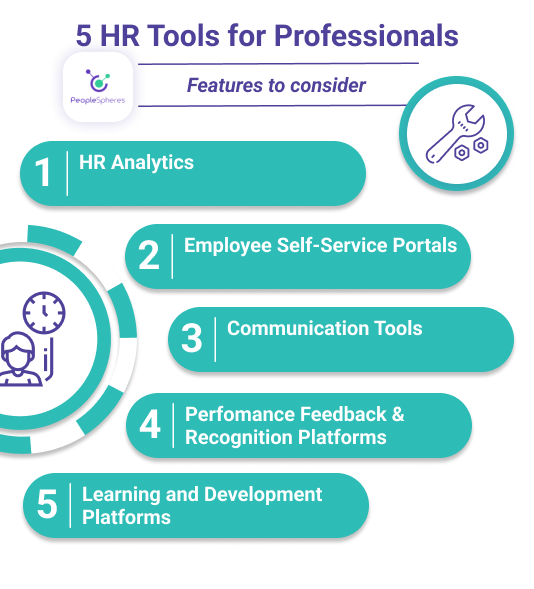
What is an HR Tool?
In the ever-evolving world of human resources, staying organized and efficient is crucial. That’s where HR tools come in. HR tools revolutionize the way HR tasks are managed, from employee onboarding to performance management and beyond. In this article, we will explore the five most widely used HR tools that are currently making a significant impact in the industry.
These tools streamline various aspects of human resource management, making it easier for professionals to handle the multitude of tasks they receive daily. Whether you’re an HR professional seeking to enhance your workflow or a business owner looking to optimize your HR operations, these HR tools are definitely worth considering.
In the following sections, we will delve into each of these 5 HR tools to provide insights into how these tools can empower HR professionals and drive organizational success creating the perfect HR strategy.
Related articles:
What are the Best Employee Engagement Strategies?
Turn Your Employer Branding into a Competitive Advantage in 8 Steps

1. Harnessing the Power of HR Analytics
HR analytics is an exceptional HR tool for professionals due to several reasons. Firstly, HR analytics enables data-driven decision-making. Traditionally, HR decisions were often based on gut feelings or limited anecdotal evidence. However, with the advent of HR analytics, HR professionals now have access to a wealth of employee data that can be analyzed and transformed into actionable insights. By leveraging employee data, HR professionals can gain valuable insights that guide strategic HR initiatives. This data-driven approach allows HR professionals to move beyond subjective decision-making and rely on objective information to address various challenges and opportunities.
Workforce Planning and Optimization
Improving HR analytics is also known to enhance workforce planning and optimization. One of the key advantages of HR analytics in workforce planning is the ability to forecast future hires needs. HR professionals can identify potential talent gaps and take proactive measures to address them by analyzing employee turnover rates and other data. This proactive approach allows organizations to identify potential talent gaps and take proactive measures to address them. This enables HR professionals to align the workforce with business goals and maintain a competitive edge.
Talent Acquisition and Retention
Along with improved workforce planning and optimization, the contribution that HR analytics makes to talent acquisition and retention is invaluable. By using AI Recruitment Software to analyze recruitment data, HR professionals can assess the effectiveness of sourcing channels, evaluate candidate qualifications, and refine the selection process. HR professionals are then able to make more informed hiring decisions and the acquisition of high-quality talent that aligns with the organization’s values and objectives.
2. Maximizing the Potential of Employee Self-Service Portals
Employee self-service portals are an invaluable HR tool for HR professionals. These portals serve as a centralized hub where employees can access and manage their personal HR information, empowering them with self-service capabilities. With the addition of these portals as an HR tool, administrative burden is reduced tenfold. By enabling employees to update their personal information, submit time-off requests, access pay stubs, and update tax information directly through the portal, HR professionals save time and effort that would have otherwise been spent on manual data entry and paperwork. Not only does this enhance efficiency but eliminating the need for manual data entry by HR professionals significantly reduces the chance of errors and inconsistencies in HRM. This leads to more reliable HR data, ensuring accurate employee records and facilitating smoother HR operations.
Accesibility & Convenience
Employee self-service portals also offer the convenience of 24/7 accessibility to HR information and services. Most portals are designed where employees can access the portal from anywhere, at any time, using their preferred device. This flexibility allows employees to conveniently view and update their information, submit HRM requests, and access relevant HR resources, irrespective of their location or time zone.
Privacy & Security
Employees no longer need to rely on the typical old-fashioned HR staff for routine tasks. HR professionals can also assign employees role-based access controls, to ensure the security and privacy of the company and its employees. By facilitating the protection of sensitive employee data and guarding against unauthorized access, Employee Self-Service Portals ensure a seamless and secure HR experience for all.
3. Promoting Collaboration with Communication Tools
Communication tools serve as an essential HR tool for professionals, offering numerous benefits in effectively managing internal communication within an organization. Communication Tools provide HR professionals with a centralized platform to disseminate information quickly and efficiently. They enable HR departments to share important updates, company-wide announcements, policy changes, and other relevant information with employees in real-time. This ensures that employees are always well-informed, promoting transparency and reducing the chances of miscommunication issues.
Enhanced Collaboration
These communication tools are especially vital when it comes to facilitating collaboration among HR professionals and employees across different departments or locations. There is no longer a need for physical memos and extensive face-to-face meetings. In the past those communication methods used to be the only way in the business-process, becoming time-consuming and costly.
HR professionals have now been taking advantage of newer tools as they have become available such as instant messaging, discussion forums, and virtual meeting capabilities to make their lives easier. These tools seamlessly deliver targeted messages, track engagement, and streamline communication processes, leading to improved teamwork and productivity.
Employee Engagement
Communication tools also play a vital role in fostering employee engagement and building a sense of community within the organization. HR professionals can engage with employees through events such as sharing a success story or celebrating a milestone. By encouraging open dialogue, Communication tools create a platform for employees to voice their ideas and contribute to a positive and inclusive work culture where they receive employee recognition.
4. Utilizing Performance Feedback and Recognition Platforms
When it comes to effectively managing and improving employee performance within organizations, performance feedback and recognition platforms stand out as a highly effective HR tool that offers significant benefits. These platforms provide HR professionals with a structured and objective framework for assessing employee performance. They enable the implementation of standardized performance evaluation processes, ensuring consistency and fairness across the organization. By providing a centralized platform for tracking and documenting performance feedback, HR professionals can make informed decisions regarding promotions, bonuses, and career development opportunities for the future.
Timely & Consistent
Performance feedback and recognition platforms also facilitate ongoing feedback between managers and employees. They allow HR professionals to provide consistent, real-time feedback, both positive and constructive, to employees on their performance. Employees are more likely to stay engaged and make necessary adjustments in their work with the feedback on these platforms leading to continuous growth and development.
Recognition
Employees greatly appreciate recognition when they actively incorporate the feedback they have received. Performance feedback and recognition platforms offer HR professionals a means to acknowledge and appreciate employee contributions effectively. There are platforms with features for professionals to give employees rewards and badges allowing HR professionals to highlight exceptional performance and foster a culture of appreciation. Recognizing employees’ efforts boosts morale, increases job satisfaction, and enhances overall employee engagement.
5. Nurturing Talent with Learning and Development Platforms
Learning and development platforms serve as invaluable HR tools, providing HR professionals with a comprehensive framework for delivering training programs and facilitating skill development initiatives. Learning and development platforms provide HR professionals with a comprehensive framework for delivering training programs and skill development initiatives. These platforms offer a wide range of learning resources, such as online courses, interactive modules, webinars, and virtual classrooms. These are all extremely important for employee development, especially when it comes to on boarding. With this access to a diverse range of learning materials provided by HR professionals, employees are encouraged to engage in ongoing self-improvement and skill enhancement.
Personalization
HR professionals can also design, and curate learning paths tailored to specific roles and skill requirements, empowering employees to acquire new knowledge and enhance their competencies. When HR professionals stay consistent with the learning and development platforms and constantly keep them up to date this creates opportunities for employees to stay updated with industry trends, best practices, and emerging technologies, ensuring their skills remain relevant in a rapidly evolving business landscape.
Another great aspect of learning and development platforms is the ability to personalize the learning experience for employees. HR professionals can identify individual learning needs and customize employee training programs accordingly through assessments, skill-gap analyses, and performance data. This personalized approach ensures that employees receive targeted learning opportunities, maximizing their development potential and fostering job satisfaction.
Cost-Effective
Compared to the traditional classroom-based approaches, learning and development platforms are known to be much more cost-effective. HR professionals can leverage the scalability of online learning to train employees at various locations simultaneously, saving time and resources while ensuring consistent training experiences.
Finally….
The five HR tools discussed in this article are instrumental in revolutionizing the way HR tasks are managed, enhancing efficiency, and driving organizational success. These tools streamline various aspects of human resource management, making it easier for HR professionals to handle their daily responsibilities. By embracing these tools and incorporating them with your own, HR professionals can optimize their workflows, improve employee engagement and productivity, make informed decisions, and propel their organizations forward in the ever-evolving landscape of human resources. Take a look at our white papers for more on how to leverage HR Tools.



-666x380.jpg)
